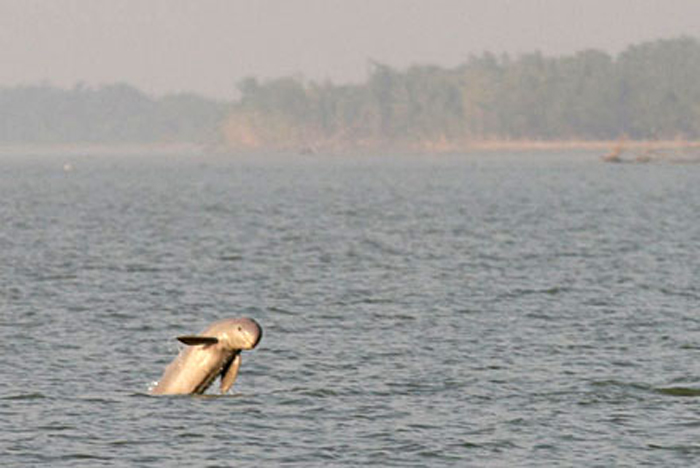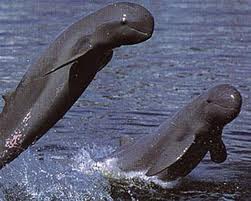New Wildlife Sanctuaries in the Sundarbans for Freshwater Dolphins
New protected areas for dolphins declared
By Staff
SPX via Terra Daily
The Government of Bangladesh recently declared three new wildlife sanctuaries for endangered freshwater dolphins in the world’s largest mangrove ecosystem – the Sundarbans, according to the Wildlife Conservation Society (WCS) whose conservation work helped pinpoint the locations of the protected areas.
The sanctuaries, which were officially declared on January 29, will protect the last two remaining species of freshwater dolphins in Asia: the Ganges River dolphin, Platanista g. gangetica, and the Irrawaddy dolphin, Orcaella brevirostris.

The Government of Bangladesh has declared three new wildlife sanctuaries for Ganges River dolphins and Irrawaddy dolphins. A WCS collaborative study with the Bangladesh Forest Department helped pinpoint the locations for the new protected areas (Credit: Rubayat Monsoor).
Although there is no global population estimate for either species, both have disappeared from major portions of their range. However, both species occur in the Sundarbans in sufficient numbers, which may serve as a global safety net for preventing their extinction.
The three wildlife sanctuaries safeguard 19.4 mi (31.4 km) of channels with a total area of 4.1 sq mi (10.7 sq km). The locations and sizes of the sanctuaries in the Sundarbans were determined according to a study conducted by WCS and Bangladesh Forest Department and published in the journal Oryx in 2010.
The study found that the habitat of Ganges River dolphins and Irrawaddy dolphins were clumped in waterways where human activities are most intense.
“Declaration of these Wildlife Sanctuaries is an essential first step in protecting Ganges River and Irrawaddy dolphins in Bangladesh,”
said Brian D. Smith, Director of the WCS’s Asian Freshwater and Coastal Cetacean Program, and first author of the study.
“As biological indicators of ecosystem-level impacts, freshwater dolphins can inform adaptive human-wildlife management to cope with climate change suggesting a broader potential for conservation and sustainable development.”
Dr. Tapan Kumar Dey, Conservator of Forests, Wildlife, Forest Department, Bangladesh, said:
“A critical component will be to engage local human communities. The wildlife sanctuaries will be used as a natural laboratory for developing management practices that balance wildlife conservation with the resource demands of a large and growing human population.”
The dolphins are threatened by fatal entanglements in fishing gear, depletion of their prey from the enormous by-catch of fish and crustaceans in fine-mesh “mosquito” nets used to catch fry for shrimp farming, and increasing salinity and sedimentation caused by sea-level rise and changes in the availability of upstream freshwater flow.
News of the declared sanctuaries is particularly welcome considering the recent extinction of the Yangtze River dolphin whose last confirmed sighting was in 2002. Fatal entanglement in nets and habitat degradation killed off this species after having survived in the Yangtze River of China for more than 10 million years.
Freshwater dolphins are among the most threatened wildlife on earth because their habitat is highly impacted by human activities, including dam construction and unsustainable fisheries.
In addition to conserving globally important populations of freshwater dolphins, the new wildlife sanctuaries in the Sundarbans will provide protection for other threatened aquatic wildlife including the river terrapin, masked finfoot, and small-clawed otter.
Bangladesh has been recognized as a “hotspot” for cetaceans, the scientific grouping of dolphins, whales, and porpoises. In April 2009, the Wildlife Conservation Society announced the discovery of the world’s largest population of nearly 6,000 Irrawaddy dolphins in the country.
A portion of this population shares habitat with the endangered Ganges River dolphin, whose range extends all the way upstream to the shadow of the Himalayas in Nepal.
Starting on February 18, 2012, WCS, through its Bangladesh Cetacean Diversity Project, will bring a boat-based dolphin exhibition called the “Shushuk Mela” to local communities bordering the Sundarbans mangrove forest.
This month-long traveling exhibition will raise awareness about the new wildlife sanctuaries and engage local fishermen and other community members in discussions on adaptive management needed to ensure human-dolphin coexistence.
Source: Terra Daily
Dolphin discovery
Bangladesh helps threatened dolphins stay afloat
By Staff
WCS
WCS researchers have discovered a stronghold for one of the world’s rarest freshwater dolphins, the Irrawaddy, deep in the waterlogged jungles of Bangladesh. The scientists counted nearly 6,000 of the dolphins in the South Asian country’s Sundarbans mangrove forest and the adjacent waters of the Bay of Bengal.

Nearly 6,000 Irrawaddy dolphins were alive and swimming in Bangladesh, according to a WCS 2009 study; prior to that study, little marine mammal research had taken place in the Sundarbans — which translates to “beautiful jungle” in Bengali — and the largest known populations of Irrawaddy dolphins numbered in the low hundreds or less. Irrawaddy dolphins are related to orcas (killer whales); Irrawaddys grow up to 8 feet and can fish cooperatively with humans (Credit: Alice Rocco).
Prior to this study, little marine mammal research had taken place in the Sundarbans—which translates to “beautiful jungle” in Bengali. Researchers had pegged the largest Irrawaddy dolphin populations in the low hundreds or fewer. In 2008, the species was listed as vulnerable on the IUCN Red List.
“This discovery gives us great hope that there is a future for Irrawaddy dolphins,” said WCS researcher Brian D. Smith, who led the study. “Bangladesh clearly serves as an important sanctuary for Irrawaddy dolphins, and conservation in this region should be a top priority.”
Despite his optimism, however, Smith and other researchers warn that the dolphins are facing increasing threats to their survival. During the study, they encountered two that had drowned after becoming entangled in fishing nets. Local fishermen say this is a common occurrence. The scientists also found that the dolphins must cope with declining freshwater supplies, caused by upstream water diversion in India coupled with sea-level rise. The latter issue has been brought on by climate change. WCS researchers are currently studying the long-term effects of this phenomenon.
These circumstances also threaten the endangered Ganges River dolphin, which shares part of its range in the Sundarbans with the Irrawaddy dolphin. The recent likely extinction of the Yangtze River dolphin, or baiji, is a potent reminder of how vulnerable freshwater dolphins are to human impacts on the environment.
Irrawaddy dolphins are related to orcas, also known as killer whales. The dolphins grow up to 8 feet long and frequent large rivers, estuaries, and freshwater lagoons in South and Southeast Asia. In Myanmar’s Ayeyarwady River, these dolphins are known to cooperatively fish with humans, helping to herd schools of fish toward boats and awaiting nets. The practice benefits the fishermen—increasing the size of their catches up to threefold—as well as the dolphins, which fill their own bellies with some of the cornered fish and those that fall out of the fishing nets.
In 2006, WCS helped establish a protected area along the Ayeyarwady River to conserve this critically endangered marine mammal population. Currently, conservationists are working closely with the Ministry of Environment and Forests in Bangladesh on plans for establishing a protected area network for the dolphins in the Sundarbans. WCS is also supporting sustainable fishing practices and helping to develop local ecotourism projects that benefit the region’s people and wildlife.
Support for this study has been provided in part by the Kerzner Marine Foundation and Ocean Park Conservation Foundation, Hong Kong; the U.S. Marine Mammal Commission; and the Convention on Migratory Species of Wild Animals, which operates a regional program for cetacean conservation in the Bay of Bengal.
Source: WCS









Comments
New Wildlife Sanctuaries in the Sundarbans for Freshwater Dolphins — No Comments